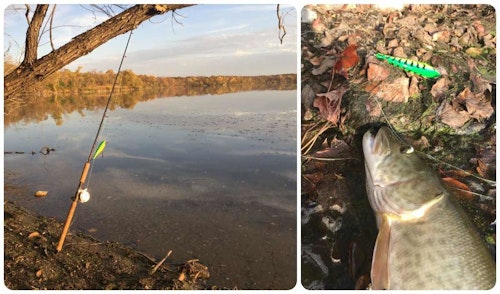Fishing from waders is a tradition for certain species; fly fishing for trout immediately comes to mind. While I enjoy targeting brookies and rainbows in creeks and rivers, I’ve recently expanded my waders adventures for gamefish found primarily in natural lakes, too.
You might assume that the reason for my waders attack plan is I don’t have access to a boat. Not so. In fact, I have three of them in my garage at all times: a 17-footer with 60hp outboard rigged with all the electronics; a 12-foot john boat that can be used with a 3hp outboard, trolling motor or oars; and a 13-foot pedal-drive kayak. So why would I ever choose to fish a lake in waders?
Reason No. 1 is minimal prep time. No matter which of the three boats I wish to use, it takes a bit of time to get rolling down the road. The kayak and john boat slide into the back of my pickup, but it still takes at least 20 minutes to load them and grab all the other necessary gear. When I simply want to get out on the water — or in the water — for 90 minutes after work before sunset, it’s easier and faster to grab my waders, one rod, a vest, a forceps to remove hooks and a small selection of lures, which I usually keep ready to roll in a Ziploc.
Reason No. 2 is there are windows of opportunity when wading allows me to fish more effectively. For example, when sunfish are on spawning beds, it’s best to stand in ankle- or knee-deep water and cast to the fish, which are usually camped in only 1.5 to 3 feet of water. In any of my boats, I’d have to anchor deeper than the spawning fish, which is a hassle, or constantly operate a trolling motor to maintain the correct casting distance. Depending on wind, this can be a challenge, and sometimes it spooks fish, too.

Another example: A nearby natural lake has one dock that’s far better than the rest for holding numbers of largemouth bass — some big ones, too. I’ve fished this dock dozens of times through the years from boats, and while I’ve done okay, nothing compared to the first time I visited the lake this late-September in waders.
From the public boat access I walked in knee-deep water to reach casting distance of the dock, and I stood in one spot casting for 2 hours. I didn’t skip a soft plastic under the dock with my first cast. Instead, I took my time, first fan casting the area near the dock but not under it.
On most visits to this lake when fishing from a boat, and casting a lot of shoreline and many docks, I average six to eight bass in a few hours, with one decent one — 3 pounds or larger.
My waders adventure forced me to slow down — way down! — and pick apart the area near and under this special dock. By sunset, after two hours of fishing, I’d caught 14 bass, including a 19-incher, 20-incher and 20.5-incher, plus numerous 15- to 17-inchers. I also broke my line on one big bass.

Maybe the better result was simply luck. However, I never felt more in control of my lure presentation when standing in thigh-deep water a comfortable casting/skipping distance from the dock. I was totally silent in waders — no trolling motor noise, no dropping an anchor.
In a previous Grand View Outdoors article called “Why Two Waders Are Better Than One,” I explained my preference for a two-waders system for fishing and hunting. The system is based on staying comfortable in the water from early spring through late fall. Owning a lightweight breathable wader is great for warm water and air, but you’ll freeze in cold conditions. Similarly, owning only a heavy neoprene wader leaves you sweating in warm conditions. Two waders with different insulation qualities is an ideal solution.

My final open-water fishing adventure of 2021 in central Minnesota occurred on a nearby muskie lake. Because the mid-October afternoon forecast was for decent weather (light winds and 60 degrees), I grabbed my LaCrosse Super Brush Tuff 5mm neoprene waders, muskie rod, two lures and planned on casting for 90 minutes before sunset. As you can see from the photo below, I was successful, landing a 35-inch muskie on a Rapala Super Shad Rap. I had another slightly larger fish follow the lure to the end of my retrieve, and I did my best to perform a figure-8 maneuver standing in waist-deep water. Not easy! The muskie followed the Super Shad Rap on a half-dozen retrieves, once nipping at the minnow imitation only a few feet from my rod tip. Exciting!
If you haven’t already, think about whether adding waders to your fishing plans makes sense. It’s not only a fun way to catch fish, but in some circumstances, it’s also the most effective method.







